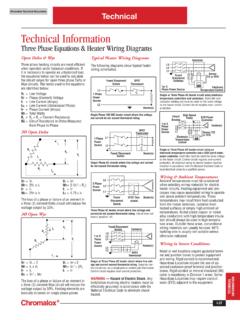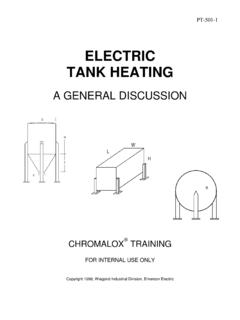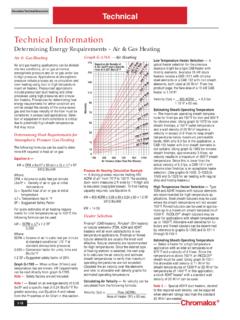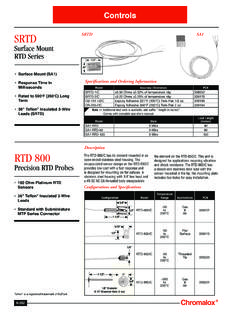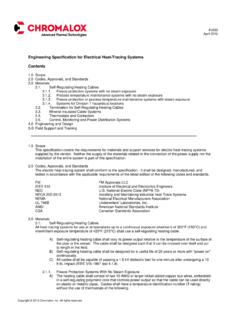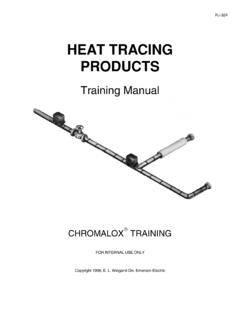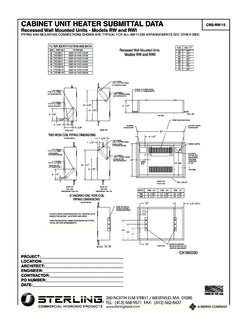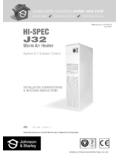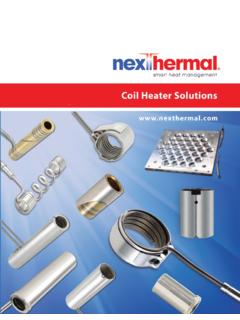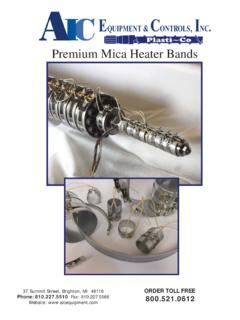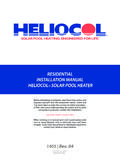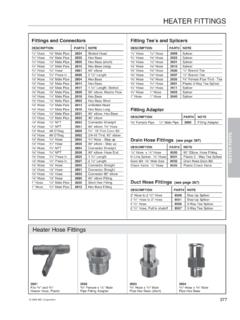Transcription of Chromalox Watt Density and Heater Selection
1 TechnicalI-13 TECHNICALINFORMATIONers or with tubular or strip heaters clamped to tank walls. The fi nal choice of Heater type will involve process considerations, appear-ance, available space both inside and outside, economy, maintenance, etc. The following pages cover the procedures for selecting heat-ers for clamp-on applications, liquid immer-sion heating, oil immersion heating, air or gas heating and cartridge or platen Heater ApplicationsThe limiting factor in most clamp-on Heater applications is the operating temperature of the Heater sheath. Selecting heaters for clamp on applications requires an analysis of the maximum expected sheath temperature based on the estimated ambient temperature and the temperature of the material being heated. Graph G-175S provides a method of estimat-ing the sheath temperature and allowable watt densities for tubular heaters for various ambi-ent temperatures and wattage G-175S Clamp-OnTubular FEstimated Ambient Temp.
2 ( F) (Sheath Temp. + Material Temp.)2 Technical InformationWatt Density & Heater Selection - GuidelinesUnderstanding Watt DensityWatt Density (W/in2) is the heat fl ux emanating from each square inch of the effective heating area (heated surface) of the = Rated Watts Effective heating areaThe effective heating area is the surface area per linear inch of the Heater multiplied by the heated length. For strip heaters which are rectangular in shape, the surface area per linear inch is:1-1/2" wide = in2 per linear inch1" wide = in2 per heated length (HL) of strip heaters is calculated as follows:< 30-1/2" long HL = Overall Length less 4" 30-1/2" long HL = Overall Length less 5"For tubular elements, watt Density is deter-mined by the following heating area = x Dia. x Heated LengthThe surface area per linear inch of standard diameter tubular elements is shown below: Size (Dia.)
3 In2/in. inch (1/4) inch (5/16) inch (3/8) inch (7/16) inch inch (1/2) following example illustrates the proce-dure for determining the watt Density of a typical tubular A 12 kW screw plug Heater has three " diameter elements with a B dimension of 32 inches and a 2 inch cold end. The watt Density x x (32 in. - 2 in.) x 3 x 2 (Hairpin) = 268 in212,000 Watts 268 in2 - 45 W/in2 For convenience in selecting equipment, all heaters in this catalog have the watt Density specifi ed for standard Selection GuidelinesOnce the total heat energy requirements have been determined, the Selection of the type of electric Heater is based on three criteria. Maximum Sheath Temperature Sheath Material Recommended Maximum Watt DensityMaximum Sheath Temperature The sheath temperature of an electric element should be limited to prevent damage to the Heater and provide reasonable life.
4 To a large extent, the maximum sheath temperature of the heating element is determined by the fi nal operating temperature of the process. In direct immer-sion applications, the sheath temperature will approximate the temperature of the heated media. In clamp-on, air and gas heating ap-plications, the operating sheath temperature can be estimated using factors derived from empirical charts and Material Element sheath material is selected based on the maximum allowable sheath temperature, the material being heated and corrosion resistance required. Depend-ing on the sheath material and construction, metal sheathed electric resistance elements will operate satisfactorily at temperatures from less than -300 F (cryogenic) to approximately 1500 F. Copper sheath elements are com-monly used for low temperature and direct immersion water heating.
5 Steel is used for oil immersion and strip Heater applications. Stainless steel and INCOLOY are used for corrosive solutions, high-temperature gas or air heating and cartridge heaters . The table below lists the maximum recommended operating temperatures for common sheath materials (UL 1030):Copper 350 F Chrome Steel 1200 FIron 750 F Stainless 300 1200 FSteel 750 F INCOLOY 1600 F1 MONEL 900 F INCONEL 1700 F1 Maximum Recommended Watt Density Some materials such as water, vegetable oils and salt baths can tolerate relatively high sheath watt densities. Other materials such as petroleum oils or sugar syrups require lower watt densities. These solutions have high vis-cosity and poor thermal conductivity. If the watt Density is too high, the material will carbonize or overheat, resulting in damage to the heating equipment or material being heated.
6 Other sections of this catalog provide guidelines and suggestions for sheath materials and recom-mended watt densities for many common heating the values determined in the Selection criteria, choose the type of Heater best suited to the application. For instance, water can be heated by direct immersion, circulation heat-403020100 Maximum Sheath (W/In2)0 200 400 600 800 1000 1200 1400 The example on the following page illustrates the procedure. 12 kW is required to heat mate-rial in a steel tank from 70 F to 800 F. Heat is to be supplied by tubular electric elements clamped to the side of the tank. Since the material is heated to 800 F, INCOLOY sheath elements must be 1 For sheath temperatures above 1500 F, contact your Local Chromalox Sales offi ce for application Use the Graph 1. Select the maximum desired work temperature on Choose either chrome steel or rust- resistant iron sheath (points B) on the basis of operating Draw a straight line through points A and B to C.
7 C gives the maximum allowable watts per square Select desired length Heater with equiva- lent or less watt Max. Work Temp. ( F)Chrome Steel SheathRust-Resistant Iron SheathABC 20 18 16 14 12 10 8 6 4 2 0 Max. W/In2 Strip Heater Selection Clamp-on ApplicationsEstimated Ambient Temp. ( F) (Sheath Temp. + Material Temp.)21200 F1100 F1000 F900 F800 F700 F600 F500 FSheathTemperatureSelecting Clamp-On TubularHeaters (cont d.)From the chart, a maximum sheath tempera-ture of 1200 F results in an average ambient temperature of (800 F + 1200 F) 2 = 1000 F. From the curves, the allowable watt Density is W/in2. Based on size of container, inch diameter TRI elements 28 in. long are TRI element has in2 per linear inch of sheath. The heated length is the overall sheath length less inches. The allowable wattage rating on the element is (28 - ) x x = 305 watts.
8 The total number of elements required is 12,000W 305W = 39 elements. Order 39 elements similar to TRI-2845 except rated 305 watts. If the application requires the use of tubular elements whose overall length is not standard, each element rating would be determined as follows: Heater Watts = (A - 2CE) (Area x )Where:A = Sheath length, overallCE = Cold pin lengthArea = Effective heated area (in2/in.) = recommended W/in2 from G-175 SSelecting Clamp-On Strips HeatersGraph G-130S provides a method of estimat-ing the maximum allowable watt Density for strip heaters for clamp on applications based on sheath operating temperature and various G-130S Clamp-On Strip heaters 200 400 600 800 1000 1200 General Recommendations forLiquid Heating ApplicationsChromalox standard immersion Heater ratings match the suggested watt densities for general purpose immersion heating.
9 Extended Heater life will be obtained by using the lowest watt Density practical for any given Ratings Water heaters 45 - 75 W/in2 Corrosive Solution heaters 20 - 23 W/in2 Oil heaters (Light Wt.) 20 - 23 W/in2 Oil heaters (Medium Wt.) 15 W/in2 Oil heaters (Heavy Wt.) 6 - 10 W/in2 Using the previous 12 kW example, determine the number of strip heaters required. An 800 F material temperature requires chrome steel strip heaters . From Graph G-130S, a maxi-mum sheath temperature of 1200 F results in an ambient temperature of 1000 F inside the space between the thermal insulation and the vessel, (800 F + 1200 F) 2 = 1000 the curve, the allowable watt Density is8 W/in2. Based on the tank size, chrome steel sheathed strip heaters 24 inches long without mounting tabs were selected. To determine the number and wattage of strip heaters needed, use the formula: allowable watts per strip = (overall length minus 4" cold section) x in2 per lineal inch of sheath x 8 watts/in2.
10 Thus (25-1/2" - 4") x x 8 = 593 (600) watts. The total number of strips required is 12,000W 600W = 20 strips. Order strips similar to OT-2507 in size but rated 600 watts. To avoid a special order, consider using 24 standard OT-2405, 500 watt strips. These heaters would have a watt Density of:500W ([23-3/4 - 4] x ) = W/in2If the application uses 3 phase power, the total element count should be a multiple of 3 to permit a balanced electrical nomograph below may also be used for Heater Selection in clamp-on strip heating InformationAllowable Watt Density & Heater Selection - Guidelines2220181614121086420 Allowable (W/In2)Strip Heater NomographSuggested Allowable Watt Densities for LiquidsMaterialMax. Temp ( F) solutions18040 Alkaline solutions (Oakite)21240 Asphalt, tar, and otherheavy or highly viscous compounds20030040050010876 Bunker C fuel oil16010 Caustic soda 2% 10% 75%210210180452515 Dowtherm A75023 Dowtherm A vaporizing75010 Dowtherm J liquid57523 Electroplating tanks18040 Ethylene glycol30030 Freon3003 Fuel oil pre-heating1809 Gasoline, kerosene30020-23 Machine oil, SAE 3025018-20 Metal melting pot500-900 20-27 Mineral oil20040020-2316 Molasses1004-5 Molten salt bath800-950 25-30 Molten tin60020-23 Oil draw bath40060020-2316 Steel cast into aluminum500-75050 Steel cast into iron750-100055 Heat transfer oils (Therminol , Mobiltherm , etc.)
